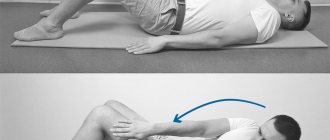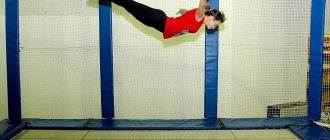The benefits of jumping rope for women, men, children
Jumping rope (the benefits of this exercise are great not only for children, but also for adults) pediatricians recommend that children from 5 to 10 years old be included in the daily exercise.
The positive effect of this type of physical activity on the child’s body is:
- strengthening the abdominal muscle corset (strong abdominal wall muscles minimize the risk of developing dysfunction of the genitourinary system in a child, and also contribute to the natural resorption of congenital umbilical hernias);
- strengthening the upper body (muscles of the arms, shoulders, back);
- promoting the formation of correct posture in the child and minimizing the likelihood of spinal curvature;
- development of general physical fitness.
The benefits of jumping rope for adult men and women are:
- strengthening the cardiovascular system;
- eliminating excess subcutaneous fat;
- acceleration of metabolic processes;
- development of dexterity and coordination;
- increasing endurance.
How to jump rope correctly to lose weight?
The jump rope, known to us since childhood, is also an inexpensive and effective cardio exercise machine. Today we will tell you how to exercise it correctly and give a table of jumping rope for weight loss.
Is it possible to lose weight by jumping rope?
Of course it is possible. Jumping is a cardio workout, and a very intense one at that: 15 minutes of energy consumption is equivalent to 30 minutes of jogging. But here lies the catch. Such an intense load is not suitable for beginners, those with low endurance, and people with a lot of weight. With poor physical fitness, you simply will not be able to jump for the time needed to burn fat. If you are overweight (when your body mass index is above 25), there is too much stress on your spine, knees, and ankles.
But for keeping yourself in good shape and polishing your figure to perfection, a jump rope is a godsend. It’s not for nothing that professional boxers, for example, use it to dry themselves off for competitions. Jump rope training is now beautifully called “skipping” (from the English skip - jump). Jumping burns approximately 7.7 kcal per 1 kg of your weight per hour. But people who are losing weight usually don’t jump for an hour; they also need to do strength exercises. Therefore, for convenience, we will calculate calories for the time that people are actually willing to spend on skipping.
Calorie consumption table: losing weight with a jump rope
| Weight/Time | 15 minutes | 20 minutes | 25 min | 30 min |
| 50 kg | 96,3 | 128,3 | 160,4 | 192,5 |
| 55 kg | 105,9 | 141,2 | 176,5 | 211,8 |
| 60 kg | 115,5 | 154 | 192,5 | 231 |
| 65 kg | 125,1 | 166,8 | 208,5 | 250,3 |
| 70 kg | 134,8 | 179,7 | 224,6 | 269,5 |
| 75 kg | 144,4 | 192,5 | 240,6 | 288,8 |
The benefits of jumping rope for weight loss
Pay attention to the bonuses that you will receive from regular jump rope training.
· General physical development and strengthening of the muscles of the whole body
. To jump, a person uses almost all muscle groups: hips, buttocks, abs, back, shoulders, arms. During landing, the muscles of the legs, buttocks, back and deep core muscles work as natural shock absorbers, taking on the shock load. This makes them stronger. But this is precisely why you can’t do jumping without first pumping up your muscles for at least a month! With undeveloped muscles, articular cartilage, which is not designed for this, will absorb shock.
· Increases endurance and strengthens the cardiovascular system
. The heart and blood vessels get used to working intensively for some time, and this increases their safety margin at rest. The more you exercise, the longer your heart system can bear the load at a lower cost.
· Fat Burning
. We have already said that skipping is a great way to lose the remaining 2-5 kg, get lean, and show muscle definition.
· Improved coordination
. Jumping trains well balance, coordination and balance of the body, and develops neuromuscular connections. After them, a person moves more deftly and harmoniously in everyday life, does not fall, slipping on a slippery floor, and so on.
How to choose jumping ropes for weight loss?
We recommend that you first buy a simple jump rope: two handles and a cord between them, adjustable in length. Handle material: wood or neoprene. You can use plain plastic, but it slips when your hands get sweaty. Any cord - rubber, PVC or rope. It’s convenient to have a jump counter in the handle. It can be mechanical or electronic; which one to choose is purely a matter of taste and budget.
Speed jump ropes spin faster because the handles have bearings. The load on them is higher, so this is a simulator for those who are trained. He is loved by CrossFit fans and boxers.
Weighted jump ropes have weights in the handles. They are usually used by wrestlers, bodybuilders and other professional athletes.
A fun new product - an electronic wireless jump rope. These are handles without a connecting cord, but with small balls on short ropes. You jump like on a regular jump rope, the balls spin and due to them the display on the handles shows the number of jumps. The gadget is convenient if you need to jump in a room where there is a risk of catching the rope on the furniture. In addition, in this case you will not hit your legs with the cord. At first it’s unusual and coordination training is not so good, but for those who only train at home, for example, while sitting with a child, this is an excellent option.
Contraindications
Skipping is not recommended:
— for pressure surges, headaches, including those caused by the weather;
- for diseases of the joints, intervertebral discs;
- within 2 months after birth;
- with vegetative-vascular dystonia, constantly elevated blood pressure;
- varicose veins;
— progressive myopia, chronic otitis media;
- with prolapse of the pelvic organs and kidneys.
How long do you need to jump rope to lose weight?
If you are a beginner, start skipping for 5 minutes in the morning and evening every other day (that is, you jump 2 times a day, rest a day). This is necessary to accustom the musculoskeletal system to intense stress. Gradually - over 2-3 weeks - move to 10-15 minutes of jumping once a day, also every other day. Then increase the skipping time by 5 minutes every week until you reach 30-35 minutes. It is better to jump after strength training or on a separate day. You can also include 10 minutes of circuit training as the first or last exercise of the circuit.
For convenience, we have compiled for you a table of the approximate number of jumps by day.
| Day | Jumping | Day | Jumping | Day | Jumping |
| 1 | 100 | 11 | 280 | 21 | 580 |
| 2 | Rest | 12 | Rest | 22 | Rest |
| 3 | 130 | 13 | 320 | 23 | 650 |
| 4 | Rest | 14 | Rest | 24 | Rest |
| 5 | 160 | 15 | 380 | 25 | 700 |
| 6 | Rest | 16 | Rest | 26 | Rest |
| 7 | 200 | 17 | 440 | 27 | 750 |
| 8 | Rest | 18 | Rest | 28 | Rest |
| 9 | 240 | 19 | 500 | 29 | 800 |
| 10 | Rest | 20 | Rest | 30 | Rest |
A more interesting option is not just to increase the number of jumps, but to jump in different ways. For example, now on one leg, now on the other, with a half-turn, and so on. Here is a sample table for those who are ready for advanced skipping
| Time | Type of jumps |
| 3 minutes | Regular jumps |
| 1 minute | Jumping with knees to chest |
| 3 minutes | Jumping with movement (moving back and forth) |
| 1 minute | Jumps with double rotation of the cord (twice under you in one jump) |
| 2 minutes | Jumping with movement (moving left and right) |
| 2 minutes | Jumping with heels to buttocks |
| 3 minutes | Jumping alternately on the right and then on the left leg |
| 2 minutes | Jumps with a turn around yourself to the right and left (if that doesn’t work, turn 900 in both directions) |
| 3-5 minutes | Regular jumps |
Now you know how and how much you need to jump rope to lose weight.
Harm and contraindications
Jumping rope, like other types of physical activity, in addition to its benefits, can also cause harm to a weakened body. If you have a number of diseases, after such exercises, joint diseases or bone pathologies may develop, the condition of the cardiovascular system may worsen, or the spine may become bent.
To avoid this, it is necessary to organize the training process taking into account the athlete’s health limitations.
Contraindications to jumping with a rolling pin are:
- diseases of the spinal column (intervertebral hernia, protrusion, etc.);
- dysfunction of the heart muscle;
- blockage of blood vessels;
- varicose veins of 2 and 3 degrees;
- old joint injuries (especially knees);
- high blood pressure;
- pregnancy;
- the beginning of the menstrual cycle (the first 3-5 days of heavy bleeding);
- diagnosed obesity of 2 and 3 degrees (intense cardio exercise with such physical data can lead to overload of the heart and joints, which will negatively affect the overall well-being of the athlete).
Jumping rope for weight loss
Among the variety of fitness equipment, the jump rope remains the most affordable and compact device. We offer you the most detailed material on training with a rolling pin: what are their benefits for losing weight, how to jump rope correctly and how to structure an exercise with a skipping rope so that it is useful for fat burning.
Before moving on to the specifics of the exercise, let's look at the benefits of training with a jump rope for weight loss and health.
The benefits of jumping rope
- Jumping rope is one of the most energy-intensive types of training. For example, according to American studies, this type of fitness allows you to burn up to 1000-1200 kcal per hour of exercise. The high effectiveness of the jump rope for weight loss explains its popularity among exercisers.
- Jumping rope is an excellent cardio exercise for increasing endurance, burning fat, and improving the functioning of the cardiovascular and respiratory systems. With a variety of exercises, you can build an effective workout that includes high and low intensity intervals.
- In addition to the cardio load, jumping rope tones a large number of muscles throughout the body: muscles of the legs, arms, buttocks, shoulders, abdomen and back.
- A jump rope is a very compact sports equipment that does not take up much space. You can always take it with you on the street or even on vacation. In terms of its convenience in this regard, a jump rope can only be compared with a fitness elastic band.
- Jumping rope is especially effective for reducing the size of the lower body. Losing weight locally is very difficult, but increasing blood flow to the “problem” area of the body gives an additional positive effect and promotes fat burning. It is not for nothing that it is believed that plyometric (jumping) exercise is most useful for losing weight in the legs.
- In addition to losing weight, jumping rope improves coordination, balance, agility and balance, which is useful both in everyday life and when playing other sports.
- A jump rope is one of the most inexpensive fitness tools that is available to everyone. Moreover, you can practice with a skipping rope anywhere, both indoors and outdoors. For training you only need a little space around you.
- Jumping rope is not only useful, but also fun. No wonder this sports equipment is so popular among children.
- Rope training strengthens the muscles that surround the ankle and foot. For example, during basketball, tennis, skiing, football and other sports, the ankle is often injured due to strong pressure on the ligaments and muscles. Regular use of a jump rope helps prevent limb injuries.
Disadvantages of jumping rope
It is impossible not to mention the disadvantages of jumping rope, and also warn about contraindications, of which there are a sufficient number.
- To jump rope, you need to have either enough space and spaciousness in the room, or the opportunity to practice outside.
- In addition, jumping creates noise, so if you live in an apartment building, then practicing with a rolling pin at home will be inconvenient.
- Jumping rope puts stress on your knee joints and ligaments, so if you are susceptible to such injuries, then it is better to avoid such exercises.
- If the technique is not followed, jumping exercises also put a strong strain on the back and lower back, which can lead to health problems.
- Jumping rope is not suitable for everyone and has a number of contraindications that are very important to remember.
Contraindications for jumping rope:
- Pregnancy and postpartum period
- Overweight (second and third degree obesity)
- Varicose veins and other vascular diseases
- Serious diseases of the cardiovascular system
- High blood pressure
- Diseases of the musculoskeletal system and spine
- Joint diseases
- Eye problems, severe visual impairment
- Asthma
If you have other chronic diseases, then before jumping rope it is better to additionally consult with a specialist. Remember that even regular walking can be used as a cardio exercise to lose excess weight. You don't have to do impact training to lose weight and get in great shape.
Features and effectiveness of skipping for weight loss
The effectiveness of skipping for weight loss is incomparable with other types of physical activity. For every 100 jumps on a rope, the athlete will be able to burn from 45 to 80 Kcal (depending on the pace of the exercise and the initial physical data of the athlete).
Provided you follow the skipping technique, in 1 hour of continuous training you can get rid of 700 - 1300 Kcal. In comparison, in 60 minutes of running on a treadmill at an average pace, a person will be able to burn no more than 800 Kcal.
An extremely high rate of getting rid of excess fat is achieved by combining cardio and strength training in this exercise. At the same time, it is almost impossible to provoke overtraining of the body when jumping rope.
Other distinctive features of skipping are:
- the ability to practice in any conditions;
- the ability to combine jumping rope with other types of cardio training;
- providing a complex load on the body (achieved by using more than 5 muscle groups).
The standard for children to perform skipping is considered to be from 85 to 150 jumps per minute, depending on the age of the young athlete. There are no generally accepted criteria for adults due to the presence of a number of diseases in the older generation that directly affect the effectiveness of their training.
Preparing for skipping
Jumping rope (the benefits are achieved only if all recommendations related to the organization of the training process and the execution of the exercise are followed) require careful preparation from the athlete.
Choosing a jump rope
When choosing a jump rope, it is recommended to familiarize yourself with the features of each of the 4 main types of sports equipment in question:
| Type of jump rope | Short description |
| Jump rope with weights | Suitable for people with good physical fitness. It is distinguished by its greater mass in comparison with traditional analogues, which complicates the performance of habitual loads. |
| Express | Recommended for use in fat burning training. Thanks to the ergonomic shape and lightweight material used in the production of the jump rope, it allows you to make more jumps in 1 minute compared to other analogues. |
| With built-in calorie burn counter | Used for fat burning training. The “smart” jump rope, after entering the athlete’s initial parameters, will independently calculate the amount of calories that must be eliminated during each session for effective weight loss. |
| Classic jump rope | It is a rubber cable with plastic handles. |
Considering that the ease of use of a jump rope is directly affected by its length, you should choose sports equipment in accordance with the generally accepted algorithm compiled by experienced fitness trainers.
Algorithm:
- Take the handles of the jump rope.
- Straighten your back.
- Stand with your feet on a part of the rubber cable lying on the floor.
- Raise your hands up. If the length is suitable for a particular person, then the maximum arm height will be opposite the armpit area.
Choice of clothes
For skipping, you should choose clothes according to the following criteria:
- wardrobe items should be as tight as possible;
- there should be no additional elements on the T-shirt or sweater (frills, ruffles, fabric inserts, etc.);
- the bra should support the breasts well (otherwise, jumping with a rolling pin can cause sagging breasts or the appearance of stretch marks);
- shoes should be elastic, soft, with non-slip soles that tightly secure the ankle;
- Jumping barefoot is not recommended, since the sole of properly selected shoes reduces the load on the joints and spine, and its absence can provoke injuries of varying complexity.
Where is the best place to study?
You can jump rope in any environment if it meets the key safety requirements:
- the floor or other supporting surface should not be slippery;
- there should be no foreign objects or people within a radius of 10 m;
- the supporting surface should be smooth, without objects that impede the movement of the lower extremities (grass, stones);
- the ambient air temperature should be no higher than 22 degrees Celsius (since jumping rope is considered a high-intensity training, performing it in hot conditions can lead to rapid dehydration, loss of consciousness or other discomfort);
- there should be a minimum of distractions around the athlete (concentration on performing the exercise increases the effectiveness of working out all the muscle groups involved).
Types of jump ropes
There are many variations of the regular jump rope on the sports equipment market. The choice depends on what results a person needs from training: losing weight, increasing endurance, or working out a specific muscle group. Models differ in length, shape, handle material, weight and come in the following types:
- Classic. Ideal for beginners to learn how to jump. They differ in the material of the handles and cord (rubber, synthetics, braided rope). The cost of such products is the lowest compared to other types.
- Express. It differs from conventional ones in the way the cord is attached to the handles - bearings are built into the handles. Due to this, a high rotation speed is achieved. Cardio training with such a jump rope is considered the most effective for weight loss.
- Weighted. This projectile has heavier handles and a thick rubber cord - the weight can be about 3 kg. Used to load the muscles of the upper body.
- With built-in counter. The counter is built into the handle and can be either mechanical or electronic. With such a jump rope it is easier to understand how much you need to jump on it in order to lose weight.
- Leather. The cord is made of leather and the handles are made of wood. Due to the fact that the handles are heavier than the cord, it rotates more slowly - you need to put in more effort to jump faster.
If you have no experience of jumping, it is better to opt for a classic or leather model. In the future, you can get a more advanced version - weighted or high-speed.
Classic jump rope
Leather
Express
With built-in counter
Weighted
Types and techniques of jumps
Jumping rope can be performed in various techniques, depending on the physical fitness of the athlete:
- jumping in place (the rubber torso should pass between the floor and the feet, minimally raised from the supporting surface);
- double jumps (the rubber rope must make 2 turns around the athlete’s body in 1 jump);
- “scissors” (at the moment of turning the rope around the athlete’s body, the legs must be crossed and have time to return them to their original position);
- jumping on one leg (an alternate jump is performed on the right and left legs, with a single twist of the rope around the athlete’s body);
- “boxer” (rotation of the rubber cable is accompanied by moving the legs from side to side);
- “pendulum” (for 1 rotation of the rubber rope you need to jump back and forth);
- running in place (jumping is replaced by changing legs, for each step of which it is necessary to rotate the rope around the athlete’s body).
Jump rope exercises
Jumping rope (the benefit will be maximum if, within one workout, you perform a variety of exercises with the sports equipment in question, avoiding the body getting used to the given load) can be complicated with the help of a number of variations.
| Exercise with a jump rope (number of approaches, repetitions and pause duration) | Description of the technique |
| Warm-up (5-7 min.) | Warm-up is necessary to prepare the muscle corset for the upcoming load. Unwarmed muscles are more susceptible to injuries and sprains. |
| Jumping backwards and forwards (2*50; rest – 30 sec) | For each rotation of the rope, you must alternately put your right and left legs forward. |
| Step-by-step jumps left and right (3*35; rest – 20 sec) | For each rotation of the rope, you must alternately spread your legs as wide as possible and return them to their original position. |
| Pelvic rotation (2*45; rest – 25 sec) | As the rubber cable passes around the athlete's body, the lower part of the body should be turned 90 degrees, while leaving the torso motionless. |
| Swing your legs forward (1 min; rest – 20 sec) | The rotation of the rubber cable is accompanied by alternate release of the straight left or right leg. |
| Jumping in a circle on 1 leg (1 min for each leg; rest – 30 sec) | With your right leg tucked under you, perform the required number of jumps, accompanied by rotating the rope. In this case, the chosen trajectory of movement should have a round shape. After the specified time, change your leg and direction of movement. |
Safety precautions
First you need to figure out how to jump rope. There are several stages of the jump:
- ready position - arms at sides, cord behind;
- starting position - legs slightly bent at the knees, hands moved away from the hips to the sides;
- rotation - correctly done not with the shoulders, but with the hands, the rope should barely touch the floor;
- jump - you need to jump rope on the balls of your feet, without your heels touching the floor.
When jumping rope, it is important to remember safety precautions. Before you start training, you need to do the following:
- Consult your doctor about your physical capabilities. If you have ever had injuries to ligaments, bones or muscles, training should be postponed until you visit a specialist.
- Choose the right shoes. It should be soft enough not to injure the foot and at the same time rigid and elastic enough to withstand loads.
- The surface on which training takes place must be hard and level.
Jumping rope for weight loss is contraindicated for people with heart disease. For the rest, the intensity and duration of training must be selected individually, guided by their own physical condition and the desired result.
Jumping rope for weight loss is not a myth. However, any training must be approached wisely. There is no need to torment an unprepared body with hours of exercise and then overeat. It is important to strictly adhere to the training program, safety precautions, and eat right. Then the extra pounds will go away much faster.
It is important to follow safety precautions during training
Monthly training program
The skipping training program for a month involves including a complex with a skipping rope in your training at least 2 times a week:
1. Monday:
- jumping in place – 30 sec;
- “staggered” jumps left and right and back and forth – 1 minute for each type of exercise;
- turning the pelvis 90 degrees while jumping – 1 min;
- swing your legs forward and backward while jumping – 40 seconds for each type of exercise;
- jumping rope, keeping your arms crossed – 80 sec;
- rotation of the rope to the right and left – 90 seconds;
- jumping rope according to the “criss-cross-jump” pattern - 2 * 30 sec;
- jumping in place at a moderate pace - 30 seconds (cool-down).
2. Thursday:
- jumping in place – 30 sec;
- double jump – 1 min;
- running with parallel rotation of the rope – 80 sec;
- jumping rope with backward movement – 2*30;
- jumping rope on 1 leg moving in a circle – 45 sec;
- squat jump – 80 reps;
- jumping from foot to foot – 3*90 sec;
- jumping in place at a moderate pace - 30 seconds (cool-down).
Common mistakes
Below is a list of the most common mistakes in performing jumping rope that prevent the athlete from quickly achieving the goal of transforming his own body.
Correct technique for jumping rope and typical mistakes in performing the exercise
The most common mistakes:
- mobility of the shoulder girdle and forearms;
- insufficient speed of the exercise;
- landing on straight legs;
- landing on the entire foot at the same time (correct execution of the exercise involves landing on the toe. This technique protects the knee joints from possible injury).
How to determine the correct length
The length of the cord depends on the person's height. The correct setting is when the cord barely touches the floor. If it is too long, it will hit the floor hard, which leads to slower rotation, and this will reduce the effectiveness of the workout and it will be much more difficult to lose weight by jumping rope.
There is a general method for determining the required length of a jump rope. To do this you need:
- stand in the middle of the rope with your foot;
- pull the handles vertically upward;
- record what height they were at.
The more experienced the athlete, the shorter his rope. There are three options for the length of the projectile according to the level of load: at shoulder level, at the level of the upper chest, at the level of the lower chest.
Beginners should choose a projectile at shoulder level. Over time, having learned to keep the pace, you can shorten the cord to the level of your upper chest. The shorter, the less room for mistakes; you need to work more intensively with your legs and arms. The most experienced athletes use a cord that reaches below chest level.
Results of training with a jump rope
Jumping rope (the benefits of regular exercise concern not only physical development, but also stabilization of the athlete’s psychological state) can help a person lose weight, increase muscle mass, improve coordination of movements and train the vestibular apparatus.
Losing fat while maintaining muscle mass
Considering that burning 1 g of fat requires an athlete to get rid of 9 Kcal, we can conclude that to reduce body weight by 1 kg, he will need to get rid of 9000 Kcal.
possible to achieve this goal and lose weight at a rate of 1 – 1.5 kg per week only if you skip regularly. In this case, only the fat layer will participate in reducing body volume, which is one of the main advantages of jumping rope.
With proper load distribution, muscle mass will remain unchanged or grow rapidly (for example, to increase the definition of the gluteal muscles, it is recommended to combine skipping with deep squats at a fast pace).
Development of anaerobic endurance
The development of anaerobic endurance is most important for professional athletes. A trained body helps them meet time standards and perform a set of exercises of an advanced level of complexity.
In order not only to develop muscle strength, but also to increase lung capacity by establishing an even pace of breathing when playing sports, professional fitness trainers recommend devoting one of the workouts per week entirely to skipping.
The duration of such a lesson should not exceed 60 minutes. Otherwise, the body will be exhausted, which will negatively affect not only the overall well-being of the athlete, but also his performance in sports.
Improved body coordination
Jumping rope helps improve coordination of movements. The need to maintain balance, taking various positions of the body and rotating the rubber cable, forces the neuromuscular connections to become stronger and more developed.
Having achieved success in skipping, an athlete becomes more dexterous in everyday conditions: he falls less often when falling on a slippery surface, reacts faster to changes in the environment, his movements become coordinated and clear.
Positive effect on the nervous system and vestibular apparatus
During a feasible cardio load that does not cause serious disruptions in heart rhythm, a large concentration of happiness hormones is released into the blood . Endorphins help minimize the consequences of stress experienced by a person, stabilize the emotional background and relieve nervous tension.
The vestibular system is also positively affected by the need for the athlete to balance when performing exercises with a jump rope.
When will the first results appear?
The speed at which positive changes in an athlete’s appearance are achieved depends on a number of external factors:
- correct execution of exercises with a skipping rope;
- initial parameters of the human body;
- regularity of skipping activities;
- compliance with the principles of proper nutrition (features of the diet are determined by the goal set by the athlete).
If all recommendations are followed, the first results will become noticeable after 1 month. regular training. The athlete will feel an improvement in his psychological state and see that his body has become more flexible and resilient.
Jumping rope is one of the most effective ways to quickly improve a person's athletic fitness.
The benefits of such sports activities are explained by the combined focus of physical activity of the type in question. The main advantage of skipping is its versatility and the minimum number of contraindications.
Jump rope for weight loss: how much should you jump?
The number of jumping ropes will depend on your endurance and sports inspiration. But in no case do not exercise too intensely, especially in the first week of training. After all, lactic acid , which will be deposited in the muscles after intense exercise, will be reflected in severe pain throughout the body.
Be prepared for all your muscles to ache after jumping.
In the first days of training, start small - do not spend time jumping for more than 5 minutes . The number of jumps per minute is no more than 80 . Gradually increase the amount of time spent - aim for the half-hour mark. But again, don’t jump too hard, it’s better to do a couple of approaches for 15 minutes than to endure 30 minutes with all your might.
Over the course of three months of constant training, your progress can be close to an hour . During this time, take 4-5 breaks for 2-3 minutes. Speed per minute – 100 – 120 jumps.
Having achieved such a result, do not strive for Olympic performance . This time is quite enough to maintain beautiful, slender body contours.











